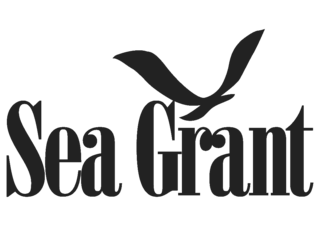
The League of American Bicyclists (LAB), officially the League of American Wheelmen, is a membership organization that promotes cycling for fun, fitness and transportation through advocacy and education. A Section 501(c)(3) nonprofit organization, the League is one of the largest membership organizations of cyclists in the United States.

The National Sea Grant College Program is a program of the National Oceanic and Atmospheric Administration (NOAA) within the U.S. Department of Commerce. It is a national network of 34 university-based Sea Grant programs involved in scientific research, education, training, and extension projects geared toward the conservation and practical use of the coasts, Great Lakes, and other marine areas. The program is administered by the National Oceanic and Atmospheric Administration (NOAA) with the national office located in Silver Spring, Maryland. There are Sea Grant programs located in every coastal and Great Lakes state as well as in Puerto Rico and Guam.
The University Corporation for Atmospheric Research (UCAR) is a US nonprofit consortium of more than 100 colleges and universities providing research and training in the atmospheric and related sciences. UCAR manages the National Center for Atmospheric Research (NCAR) and provides additional services to strengthen and support research and education through its community programs. Its headquarters, in Boulder, Colorado, include NCAR's Mesa Laboratory, designed by I.M. Pei.

The Southeastern United States, also referred to as the American Southeast, the Southeast, or the South, is a geographical region of the United States located in the eastern portion of the Southern United States and the southern portion of the Eastern United States. The region includes a core of states that reaches north to Maryland and West Virginia, bordering the Ohio River and Mason–Dixon line, and stretches west to Arkansas and Louisiana.
SURAnet was a pioneer in scientific computer networks and one of the regional backbone computer networks that made up the National Science Foundation Network (NSFNET). Many later Internet communications standards and protocols were developed by SURAnet.

Thomas Jefferson National Accelerator Facility (TJNAF), commonly called Jefferson Lab or JLab, is a US Department of Energy National Laboratory located in Newport News, Virginia.

GlueX is a particle physics experiment located at the Thomas Jefferson National Accelerator Facility (JLab) accelerator in Newport News, Virginia. Its primary purpose is to better understand the nature of confinement in quantum chromodynamics (QCD) by identifying a spectrum of hybrid and exotic mesons generated by the excitation of the gluonic field binding the quarks. Such mesonic states are predicted to exist outside of the well-established quark model, but none have been definitively identified by previous experiments. A broad high-statistics survey of known light mesons up to and including the is also underway.
Oak Ridge Associated Universities (ORAU) is a consortium of American universities headquartered in Oak Ridge, Tennessee, with offices in Arvada, Colorado and Cincinnati, Ohio and staff at other locations across the country.
The Council of Public Liberal Arts Colleges (COPLAC) is a consortium of 30 public colleges and universities in 27 states and one Canadian province. Established in 1987, COPLAC advances the aims of its member institutions and drives awareness of the value of public liberal arts education in a student-centered, residential environment.
The Universities Research Association is a non-profit association of more than 90 research universities, primarily but not exclusively in the United States. It has members also in Japan, Italy, and in the United Kingdom. It was founded in 1965 at the behest of the President's Science Advisory Committee and the National Academy of Sciences to build and operate Fermilab, a National Accelerator Laboratory. Today, the mission of URA is "to establish and operate in the national interest unique laboratories and facilities for research, development, and education in the physical and biological sciences to expand the frontiers of knowledge, foster innovation, and promote the education of future generations of scientists."
CEBAF Large Acceptance Spectrometer (CLAS) is a nuclear and particle physics detector located in the experimental Hall B at Jefferson Laboratory in Newport News, Virginia, United States. It is used to study the properties of the nuclear matter by the collaboration of over 200 physicists from many countries all around the world.
The Association of Public and Land-grant Universities (APLU) is a research, policy, and advocacy organization of public research universities, land-grant institutions, state university systems, and higher education organizations. It has member campuses in all of the United States as well as the District of Columbia, four U.S. territories, Canada, and Mexico.
The National Institute of Aerospace (NIA) is a non-profit research and graduate education institute headquartered in Hampton, Virginia, near NASA's Langley Research Center.
Elizabeth J. (Betsy) Beise is a Professor of Physics and Associate Provost at the University of Maryland, College Park. She works on quantum chromodynamics, nucleon structure and fundamental symmetries.

Cynthia E. Keppel is the Hall A and C Leader at the Thomas Jefferson National Accelerator Facility and a Fellow of the American Physical Society. Her research focuses on the quark-gluon structure of the nucleon, while also considering applications of nuclear physics in medicine. She was a founding member of the Hampton University Proton Therapy Institute.
John Dirk Walecka, often quoted as J. Dirk Walecka is an American theoretical nuclear and particle physicist. He is a fellow of the American Physical Society and the author of numerous textbooks in physics. Walecka is currently the Governor's Distinguished CEBAF Professor of Physics, Emeritus at the College of William and Mary.

Volker D. Burkert is a German physicist, academic and researcher. He is a Principal Staff Scientist at the Thomas Jefferson National Accelerator Facility at Jefferson Lab (JLab) in Newport News, Virginia (USA). He has made major contributions to the design of the CEBAF Large Acceptance Spectrometer (CLAS) that made it suitable for high luminosity operation in experiments studying spin-polarized electron scattering.







